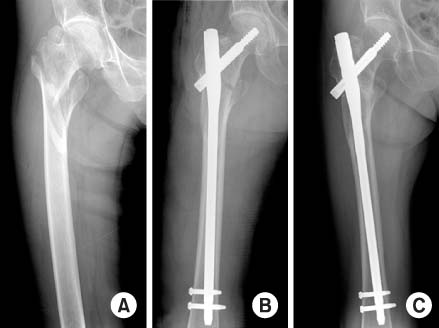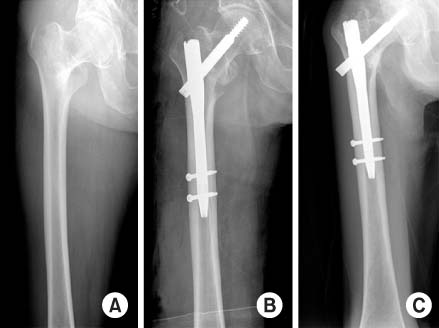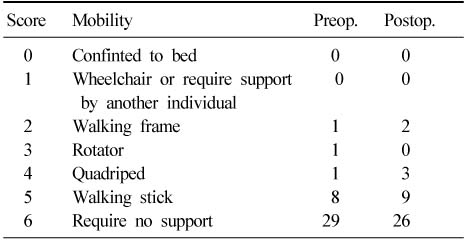Articles
- Page Path
- HOME > J Musculoskelet Trauma > Volume 21(4); 2008 > Article
-
Original Article
- Operative Treatment with ITST in Femur Trochanteric Fracture
- Ki-Do Hong, M.D., Jae-Chun Sim, M.D., Sung-Sik Ha, M.D., Jae-Young Kim, M.D., Jung-Ho Kang, M.D., Kwang-Hee Park, M.D.
-
Journal of the Korean Fracture Society 2008;21(4):274-278.
DOI: https://doi.org/10.12671/jkfs.2008.21.4.274
Published online: October 31, 2008
Department of Orthopedic Surgery, Seoul Adventist Hospital, Seoul, Korea.
- Address reprint requests to: Jae-Chun Sim, M.D. Department of Orthopedic Surgery, Seoul Adventist Hospital, 29-1, Hwigyeong 2-dong, Dongdaemun-gu, Seoul 130-711, Korea. Tel: 82-2-2210-3581, Fax: 82-2-2217-1897, gowinfree@nate.com
• Received: April 26, 2008 • Revised: July 2, 2008 • Accepted: July 23, 2008
Copyright © 2008 The Korean Fracture Society. All rights reserved.
This is an Open Access article distributed under the terms of the Creative Commons Attribution Non-Commercial License (http://creativecommons.org/licenses/by-nc/3.0/) which permits unrestricted non-commercial use, distribution, and reproduction in any medium, provided the original work is properly cited.
- 546 Views
- 0 Download
- 1 Crossref
Abstract
-
Purpose
- To evaluate the clinical and radiographic results of treatment of trochanteric fracture with ITST (Intertrochanteric/Subtrochanteric) nail.
-
Materials and Methods
- We reviewed the results of 40 cases of trochanteric fracture treated with ITST from January 2006 to May 2007, which could be followed up for more than 12 months. The cases include 13 males and 27 females, and the mean age is 75.6 years old. The clinical results were evaluated by Ceder mobility assessment, and the radiographic results were evaluated by the change of femoral neck-shaft angle and sliding of lag screw.
-
Results
- The mean bone union time is 13.5 weeks. Thirty four cases (85%) were recovered to pre-injury state of walking ability. The change of neck-shaft angle was an average of 5.21° and the sliding distance of lag screw was an average of 5.78 mm. Complications were occurred in 4 patients (10%).
-
Conclusion
- The ITST nail were seen good results in treatment of trochanteric fracture and has relatively less complications than other internal fixator.
- 1. Ahn SJ, Park JH. Proximal femoral nail (PFN) for the treatment of the femoral trochanteric fracture. J Korean Fract Soc, 2004;17:7-12.Article
- 2. Banan H, Al-Sabti A, Jimulia T, Hart AJ. The treatment of unstable extracapsular hip fractures with the AO/ASIF proximal femoral nail (PFN)-our first 60 cases. Injury, 2002;33:401-405.Article
- 3. Bridle SH, Patel AD, Bircher M, Calvert PT. Fixation of intertrochanteric fractures of the femur. A randomized prospective comparison of the gamma, nail and the dynamic hip screw. J Bone Joint Surg Br, 1991;73:330-334.
- 4. Butt MS, Krikler SJ, NAfie S, Ali MS. Comparison of dynamic hip screw and gamma nail: a prospective, randomized, cotrolled, trial. Injury, 1995;26:615-618.Article
- 5. Ceder L, Lindberg L, Odberg E. Differential care of hip fracture in the elderly. Acta Orthop Scand, 1980;51:157-162.
- 6. Chapman MW, Bray TJ, Spiegel DG, Green SA. Operative orthopaedics. 2nd ed. Philadelphia: JB Lippincott Co; 1993. p. 595-620.
- 7. Chevalley F, Gamba D. Gamma nailing of peritrochanteric and subtrochanteric fractures: clinical results of a series of 63 conservative cases. J Orthop Trauma, 1997;11:412-415.
- 8. Crenshaw AH. Campbell's operative orthopaedics. 8th ed. St Louis: Mosby Year Book Co; 1992. p. 896-929.
- 9. Davis TR, Sher JL, Horsman A, Simpson M, Porter BB, Checketts RG. Intertrochanteric femoral fractures. Mechanical failure after internal fixation. J Bone Joint Surg Br, 1990;72:26-31.ArticlePDF
- 10. Evans EM. The treatment of trochanteric fractures of the femur. J Bone Joint Surg Am, 1949;31:190-203.ArticlePDF
- 11. Halder SC. The gamma nail for peritrochanteric fractures. J Bone Joint Surg Br, 1992;74:340-344.
- 12. Hardy DC, Descamps PY, Krallis P, et al. Use of intramedullary hip-screw compared with a compression hipscrew with a plate for intertrochanteric femoral fractures. A prospective, randomized study of one hundreds patients. J Bone Joint Surg Am, 1998;80:618-630.
- 13. Jung PH, Hwang JS, Kang S, Kwak JY. Comparative study between intramedullary hip screw and compression hip screw fixation group in the treatment of femoral intertrochanteric fracture. J Korean Hip Soc, 2004;16:63-70.
- 14. Kim BS, Lew SG, Ko SG, Cho SD, Yang JH, Park MS. Treatment of femoral intertrochanteric fracture with proximal femoral nail. J Korean Hip Soc, 2004;17:1-6.
- 15. Kyle RF. Biomechanical analysis of the sliding characteristics of compression hip screws. J Bone Joint Surg Am, 1980;62:1308-1314.
- 16. Kyle RF, Gustilo RB, Premer RF. Analysis of six hundred and twenty-two intertrochanteric hip fractures. J Bone Joint Surg Am, 1979;61:216-221.
- 17. Lee SY, Park IH, Song KW, Shin SI, Lee JY, Cha JH. The result of proximal nailing (PEN(R)) for unstable femoral peritrochanteric fractuer. J Korean Soc Fract, 2003;16:143-147.
- 18. Leung KS, So WS, Shen WY, Hui PW. Gamma nails and the dynamic hip screws for peritrochanteric fractures. A randomized prospective study in elderly patients. J Bone Joint Surg Br, 1992;74:345-351.
- 19. Madsen JE, Naess L, Aune AK, Alho A, Ekeland A, Strømsøe K. Dynamic hip screw with trochanteric stabilizing plate in the treatment of unstable proximal femoral fractures: a comparative study with gamma nail and compression hip screw. J Orthop Trauma, 1998;12:241-248.
- 20. Orthopaedic Trauma Association Committee for Coding and Classification. Fracture and dislocation compendium. Orthopaedic trauma association Committee for coding and classification. J Orthop Trauma, 1996;10:Suppl 1. v-ix. 1-154.
- 21. Rosenblum SF, Zuckerman JD, Kummer FJ, TOM BS. A biomechanical evaluation of the gamma nail. J Bone Joint Surg Br, 1992;74:352-357.
REFERENCES
Fig. 1

(A) Lt. femur AP view shows A2 type unstable intertrochanteric fracture (according to OTA/OA classification) of 77 years old female patient. (B) Immediate postoperative radiograph shows acceptable reduction and fixation. (C) 8 months postoperative radiograph shows that complete bone union was obtained.

Fig. 2

(A) Rt. femur AP view shows A1 type stable intertrochanteric fracture (according to OTA/OA classification) of 78 years old male patient. (B) Immediate postoperative radiograph shows peri-distal stem fracture. (C) 10 months postoperative radiograph shows that nearly complete bone union of peri-distal stem and intertrochanteric fracture was obtained, and that 7° varus change with 10 mm lag screw sliding was obtained.

Figure & Data
REFERENCES
Citations
Citations to this article as recorded by 

- Treatment of the Intertrochanteric Femoral Fracture with Proximal Femoral Nail: Nailing Using the Provisional K-wire Fixation
Gu-Hee Jung
Journal of the Korean Fracture Society.2011; 24(3): 223. CrossRef
Operative Treatment with ITST in Femur Trochanteric Fracture


Fig. 1
(A) Lt. femur AP view shows A2 type unstable intertrochanteric fracture (according to OTA/OA classification) of 77 years old female patient. (B) Immediate postoperative radiograph shows acceptable reduction and fixation. (C) 8 months postoperative radiograph shows that complete bone union was obtained.
Fig. 2
(A) Rt. femur AP view shows A1 type stable intertrochanteric fracture (according to OTA/OA classification) of 78 years old male patient. (B) Immediate postoperative radiograph shows peri-distal stem fracture. (C) 10 months postoperative radiograph shows that nearly complete bone union of peri-distal stem and intertrochanteric fracture was obtained, and that 7° varus change with 10 mm lag screw sliding was obtained.
Fig. 1
Fig. 2
Operative Treatment with ITST in Femur Trochanteric Fracture
Motility assessment (Ceder et al.)
Table 1
Motility assessment (Ceder et al.)

 E-submission
E-submission KOTA
KOTA TOTA
TOTA TOTS
TOTS

 Cite
Cite

